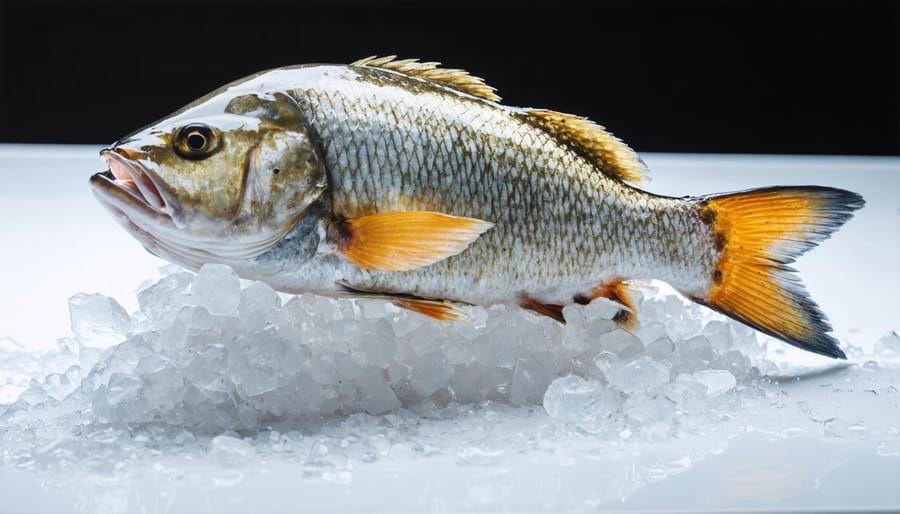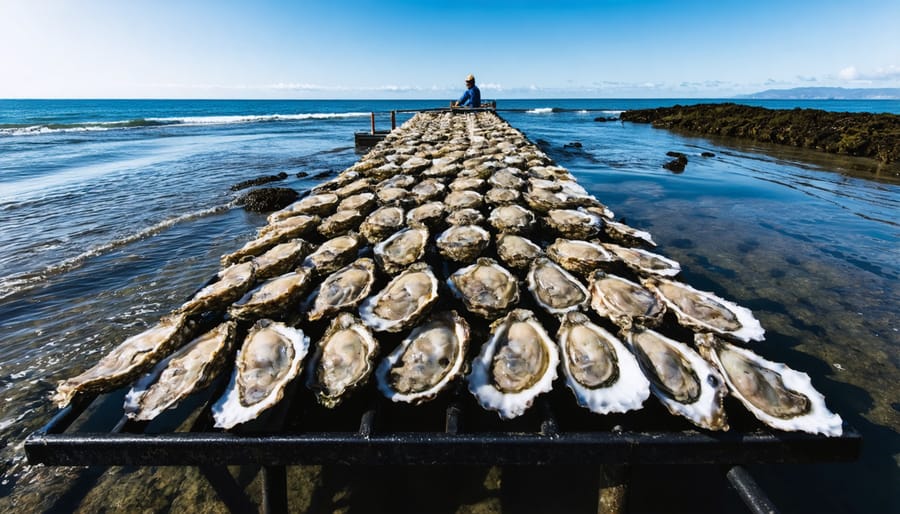Making sustainable seafood choices is no longer optional – it’s crucial for protecting our oceans and ensuring future generations can enjoy seafood. As Australian waters face increasing pressure from overfishing and climate change, knowing which seafood options to choose has become essential for both consumers and businesses.
The sustainable seafood landscape in Australia is constantly evolving, with species moving between ‘recommended’ and ‘avoid’ lists based on current fishing practices and population assessments. From the abundant stocks of wild-caught Australian sardines to carefully managed Tasmanian salmon farms, sustainable options are available across different price points and culinary preferences.
This comprehensive guide cuts through the complexity of seafood sustainability, offering clear direction on which species to choose, where to find them, and how to verify their environmental credentials. Whether you’re a chef sourcing ingredients for your restaurant, a family planning weekly meals, or a retailer stocking your shelves, understanding sustainable seafood choices helps protect our marine ecosystems while supporting responsible fishing practices.
Let’s dive into Australia’s sustainable seafood options and discover how making informed choices can create positive change for our oceans.
Understanding Sustainable Seafood in Australia
Local vs. Imported: Making Informed Choices
When choosing seafood in Australia, the decision between local and imported options can significantly impact our marine ecosystems. Australian fisheries generally maintain high sustainability standards, with strict regulations and monitoring practices. Local seafood often has a smaller carbon footprint due to reduced transportation needs, and supporting local fisheries helps maintain our coastal communities.
However, the choice isn’t always straightforward. While reducing seafood consumption remains the most effective way to decrease pressure on marine resources, when you do purchase seafood, consider both origin and fishing methods. Some Australian species, like Western Rock Lobster and Spencer Gulf King Prawns, are internationally recognised for their sustainable practices.
Imported seafood can be sustainable too, particularly when certified by recognised organisations. However, it’s essential to check labelling carefully, as some imported products may come from regions with less stringent environmental regulations. Look for country of origin labels and sustainability certifications to make informed choices. Remember that frozen imported fish might sometimes have a lower environmental impact than fresh local options that require energy-intensive refrigerated transport across our vast continent.
Certification Labels to Look For
When shopping for sustainable seafood in Australia, keep an eye out for these trusted certification labels that guarantee responsible sourcing. The Marine Stewardship Council (MSC) blue fish tick is one of the most recognised and respected certifications worldwide. Look for this label on wild-caught seafood products – it ensures the fish comes from well-managed fisheries that maintain healthy populations and minimise environmental impact.
For farmed seafood, the Aquaculture Stewardship Council (ASC) certification is your go-to mark of sustainability. This label confirms that your seafood comes from farms that protect water quality, preserve local ecosystems, and maintain high animal welfare standards.
AMCS’s GoodFish Project offers a traffic light system specifically for Australian seafood. Their green-listed choices represent the most sustainable options available in our local markets. Some retailers also use the ‘Sustainable Choice’ label, developed by the Sydney Fish Market, which identifies seafood that meets strict environmental criteria.
Remember that these labels are regularly updated based on the latest scientific assessments, so you can trust them to guide your sustainable seafood choices.
Best Sustainable Seafood Options in Australia
Wild-Caught Sustainable Species
Australia’s waters are home to numerous sustainable wild-caught species that make excellent choices for environmentally conscious consumers. Leading the pack is the Australian Sardine, primarily caught in South Australia and Western Australia using low-impact purse seine methods. These small but mighty fish reproduce quickly and maintain healthy population levels.
Another stellar choice is the Western Rock Lobster from Western Australia, which has earned international recognition for its sustainable management practices. The fishery operates under strict quotas and uses pots that minimise impact on the seafloor and reduce bycatch.
Yellow-fin Whiting and King George Whiting from southern Australian waters are also sustainable options when caught using hook and line methods. These species have stable populations and are managed through effective size limits and seasonal closures.
The Eastern School Whiting deserves special mention for its abundant populations and the selective fishing methods used in its harvest. Similarly, Australian Salmon (which isn’t related to Atlantic Salmon) is a sustainable choice when caught using beach seine nets.
For those seeking sustainable prawns, Spencer Gulf King Prawns stand out. This fishery has implemented innovative practices to reduce bycatch and protect seabed habitats. Balmain Bugs and Endeavour Prawns from Queensland waters, when caught using modern trawling methods with turtle exclusion devices, are also sustainable choices.
Remember that sustainability status can change, so it’s worth checking current recommendations through recognised seafood guides or certification programs.

Responsibly Farmed Fish
Responsible fish farming in Australia has become a beacon of sustainability in our seafood industry. From Tasmania’s pristine salmon farms to Queensland’s barramundi operations, aquaculture facilities are increasingly adopting environmentally conscious practices. These farms are leading the way in providing sustainable alternatives to wild-caught fish while protecting our marine ecosystems.
Australian aquaculture stands out for its stringent environmental standards and innovative practices. Many farms now use advanced monitoring systems to maintain water quality and reduce environmental impact. For instance, Tasmania’s salmon farmers have pioneered the rotation of farming sites to allow seabeds to recover, while barramundi farms in northern Australia utilise sophisticated recycling systems that minimise water usage.
When choosing farmed fish, look for ASC (Aquaculture Stewardship Council) certification, which guarantees environmental responsibility and social accountability. Some excellent sustainable choices include Australian-farmed barramundi, rainbow trout, and yellowtail kingfish. These species not only provide healthy organic seafood options but also support local communities and reduce pressure on wild fish populations.
Many Australian fish farms are also embracing innovative feed solutions, moving away from wild-caught fish meal to sustainable alternatives like algae-based feeds and agricultural by-products. This shift helps preserve wild fish stocks while maintaining the nutritional quality of farmed fish. Supporting these responsible farming practices ensures a sustainable future for Australia’s seafood industry while protecting our precious marine environment.

Seasonal Choices
Making local and seasonal choices when selecting seafood not only supports sustainability but also ensures you’re getting the freshest catch possible. In Australia, our seafood seasons follow distinct patterns that smart consumers can use to make better choices.
During summer months (December-February), opt for species like yellowfin tuna, Australian salmon, and flathead. These fish are abundant during warmer months and choosing them helps reduce pressure on other species during their breeding seasons.
Autumn (March-May) brings excellent opportunities for blue grenadier, Australian sardines, and prawns from Queensland. These choices are particularly sustainable when sourced from certified Australian fisheries.
Winter (June-August) is perfect for enjoying Australian rock oysters, blue mussels, and pink ling. These species thrive in cooler waters and are at their peak quality during these months.
Spring (September-November) offers fantastic choices including whiting, calamari, and Spencer Gulf prawns. This season also marks the return of many migratory species to Australian waters.
Remember that availability can vary by region, so check with your local fishmonger about what’s currently in season. Many markets now display seasonal calendars to help guide your choices, making it easier to support sustainable fishing practices while enjoying the best seafood Australia has to offer.
Seafood to Avoid
Threatened Species
As responsible consumers, it’s crucial to be aware of endangered fish species and make informed choices to protect our marine ecosystems. In Australian waters, several species are currently facing significant threats. The Southern Bluefin Tuna, though showing signs of recovery, remains vulnerable and requires continued protection. Orange Roughy, which can live up to 150 years, has been severely impacted by overfishing. School Shark populations have declined dramatically, and Eastern Gemfish numbers are still concerning despite fishing restrictions.
Other species to avoid include the Grey Nurse Shark, Blue Warehou, and Gulper Sharks. These species are particularly vulnerable due to their slow growth rates and late maturity. The Black Jewfish and Queensland Groper, both popular in Australian seafood markets, are also under pressure from overfishing.
By choosing alternatives to these threatened species, we can help their populations recover while still enjoying sustainable seafood options. Many delicious and abundant alternatives are available, such as Australian Salmon, Yellowtail Kingfish, and farmed Barramundi.
Unsustainable Fishing Methods
While enjoying seafood is part of our Australian way of life, certain fishing methods can harm marine ecosystems and deplete fish populations. Bottom trawling, for instance, drags heavy nets across the seafloor, damaging coral reefs and seabed habitats that many species call home. This practice is particularly concerning in the Great Barrier Reef region.
Longline fishing poses significant risks to seabirds, turtles, and sharks who often become unintended catch. In Australian waters, this has impacted populations of endangered albatross species and sea turtles. Similarly, gillnets, which create invisible walls in the water, often entangle dolphins, dugongs, and other marine mammals.
Blast fishing, though illegal, still occurs in some Indo-Pacific waters and destroys coral reefs that can take decades to recover. Cyanide fishing, used to catch live fish for aquariums, poses risks to both marine life and human health.
By understanding these harmful practices, we can make better choices at the fish market and support fisheries using sustainable methods like pole-and-line fishing, trap fishing, or carefully managed aquaculture operations.
Where to Buy Sustainable Seafood
Local Markets and Fishmongers
Australia’s coastal communities are home to numerous local markets and fishmongers who prioritise sustainable seafood practices. These trusted local sources often have direct relationships with fishers and can provide detailed information about where and how their seafood was caught.
The Sydney Fish Market, Australia’s largest seafood market, has implemented a comprehensive sustainability commitment, working closely with suppliers who follow responsible fishing practices. Similar initiatives can be found at Melbourne’s Queen Victoria Market and Brisbane’s Fish Factory, where vendors clearly label sustainable choices.
Many local fishmongers are now embracing technology to enhance transparency. Look for those using QR codes or digital tracking systems that allow you to trace your seafood’s journey from ocean to plate. Some standout examples include The Fish Shoppe in Melbourne and Claudio’s Quality Seafoods in Sydney, both known for their commitment to sustainability and detailed product information.
Community-supported fisheries (CSFs) are also gaining popularity across coastal Australia. These programs connect consumers directly with local fishing families, offering seasonal catches through subscription services. This model not only ensures fresher seafood but also supports sustainable fishing practices and local communities.
When visiting your local fishmonger, don’t hesitate to ask questions about their sourcing practices. Responsible vendors will be happy to share information about catch methods, locations, and seasonality. Look for those displaying sustainable certification logos and offering detailed product information.
Supermarket Shopping Tips
Making sustainable seafood choices at your local supermarket doesn’t have to be complicated. Most major Australian retailers now offer clearly labelled sustainable options, making it easier than ever to shop responsibly. Look for the blue MSC (Marine Stewardship Council) label or the green ASC (Aquaculture Stewardship Council) label on packaged products – these certifications guarantee your seafood comes from sustainable sources.
When shopping at the seafood counter, don’t hesitate to ask staff about the origin of their products. Many supermarkets now train their team members on sustainability practices and can provide valuable information about their seafood sourcing. Keep an eye out for Australian-caught options, as our local fishing industry often follows stricter sustainability guidelines than some international sources.
Download your supermarket’s sustainable seafood shopping guide to your phone, or grab a printed copy in-store. Coles and Woolworths both offer comprehensive guides that are regularly updated with seasonal information. These guides typically use a simple traffic light system – green for best choice, amber for think twice, and red for avoid.
Remember to check frozen options too, as these can often be more sustainable than fresh alternatives. Many frozen products are processed immediately after catching, maintaining quality while reducing waste. When in doubt, choose Australian farmed species like barramundi, which typically have excellent sustainability credentials.
Making sustainable seafood choices isn’t just about protecting our oceans – it’s about securing a future where our children and grandchildren can continue to enjoy Australia’s rich marine bounty. By referring to sustainable seafood lists and following the guidelines we’ve discussed, each of us can make a meaningful difference in preserving our marine ecosystems.
Remember, sustainable choices are often as simple as opting for locally caught fish, checking eco-certifications, and being mindful of seasonality. Whether you’re picking up fresh fish at your local market or dining out, asking questions about the source of your seafood sends a powerful message through the supply chain.
The good news is that sustainable seafood options are becoming increasingly available across Australia. From MSC-certified canned tuna to responsibly farmed barramundi, making better choices has never been easier. Many retailers and restaurants are now proudly highlighting their sustainable offerings, making it simpler for consumers to identify and choose ocean-friendly options.
Take the first step today by downloading a sustainable seafood guide, chatting with your local fishmonger, or looking for eco-certified products. Every sustainable choice you make helps protect our marine environments, supports responsible fishing practices, and contributes to the long-term viability of Australia’s fishing industry.
Together, we can ensure our oceans remain healthy and productive for generations to come. Your choices matter, and they’re part of a growing movement towards more sustainable seafood consumption in Australia.
